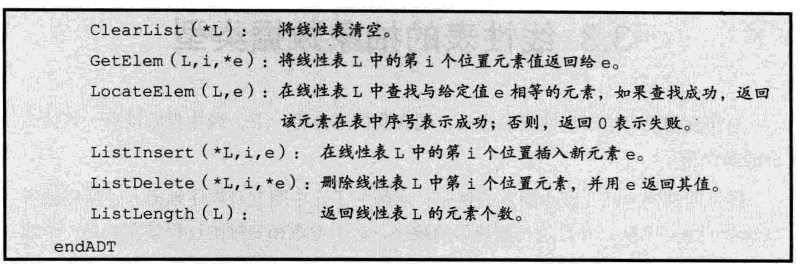标签:sem count row clear false let 头插法 IV data
本文根据《大话数据结构》一书,实现了Java版的单链表。
书中的线性表抽象数据类型定义如下(第45页):


实现程序:
package LinkList;
/**
* 说明:
* 1.《大话数据结构》中没有线性表的长度,但提到可以存储于头节点的数据域中。
* 本程序的线性表长度存放于count变量中,线性表长度可以使程序比较方便。
* 2.程序中,第i个位置代表第i个结点,头结点属于第0个结点
* 3.因为链表为泛型,整表创建采用整型(随机整数做元素),所以有出现一些类型转换
* 4.Java程序的方法一般以小写开头,但为和书上一致,程序中方法采用了大写开头。
*
* 注意点:
* 1.count在增删元素时要加一或减一千万别忘了
* 2.清空线性表要每个元素都null
*
* @author Yongh
*
*/
public class LinkList<E> {
private Node<E> head; //头结点
private int count; //线性表长度(《大话》存储于head.data中)
/**
* 结点
*/
private class Node<E>{
E data;
Node<E> next;
public Node(E data,Node<E> next){
this.data=data;
this.next=next;
}
}
/**
* 线性表的初始化
*/
public LinkList(){
head=new Node<E>(null, null); //不是head=null;
count=0;
}
/**
* 判断线性表是否为空
*/
public boolean IsEmpty() {
if(count==0) {
System.out.println("表为空!");
return true;
}else {
System.out.println("表不为空!");
return false;
}
//return count==0;
}
/**
* 清空线性表(自己编写的)
*/
public void ClearList() {
Node<E> node;
while(count!=0) {
node=head.next;
head.next=node.next;
node=null;
count--;
}
System.out.println("线性表已清空!");
}
/**
* 清空线性表(书中改写)
*/
public void ClearList2() {
Node<E> q,p;
q=head.next;
while(q!=null) {
p=q.next;
q=null;
q=p;
count--;
}
head.next=null;
System.out.println("线性表已清空!");
}
/**
* 获取第i个结点(包括第0个结点,头结点)
* 获取结点值只需要GetNode(i).data即可,不再写方法了
*/
public Node<E> GetNode(int i) {
if(i<0||i>count) {
throw new RuntimeException("元素位置错误!");
}else if (i==0) {
return head;
}else {
Node<E> node=head.next;
for(int k=1;k<i;k++) {
node=node.next;
}
return node;
}
}
/**
* 获取第i个结点的数据(包括头结点)
*/
public E GetData(int i) {
return GetNode(i).data;
}
/**
* 查找元素,0代表查找失败
*/
public int LocateElem(E e) {
Node<E> node;
node=head.next;
if(node.data==e)
return 1;
for(int k=1;k<count;k++) {
node=node.next;
if(node.data==e)
return k+1;
}
System.out.println("查找失败!");
return 0;
}
/**
* 第i个位置插入新的元素
*/
public void ListInsert(int i,E e) {
if(i<1||i>count+1) {
throw new RuntimeException("插入位置错误!");
}else {
Node<E> newNode=new Node<E>(e,null);
newNode.next=GetNode(i-1).next; //因为GetNode()方法中包含了获取头结点,所以不需单独判断了
GetNode(i-1).next=newNode;
count++;
System.out.println("插入成功!");
}
}
/**
* 删除第i个位置元素,并返回其值
*/
public E ListDelete(int i) {
if(i<1||i>count)
throw new RuntimeException("删除位置错误!");
Node<E> node=GetNode(i);
E e=node.data;
GetNode(i-1).next=node.next;
node=null;
count--;
System.out.println("删除成功!");
return e;
}
/**
* 获取线性表长度
*/
public int ListLength() {
return count;
}
/**
* 整表创建,头插法
*/
public LinkList<Integer> CreateListHead(int n){
LinkList<Integer> list1=new LinkList<Integer>();
Node<Integer> node,lastNode;
for(int i=0;i<n;i++) {
int data=(int)(Math.random()*100); //生成100以内的随机数
node=new Node<Integer>(data, null);
node.next=(LinkList<E>.Node<Integer>) list1.head.next;
list1.head.next=(LinkList<Integer>.Node<Integer>) node;
list1.count++;
}
return list1;
}
/**
* 整表创建,尾插法
*/
public LinkList<Integer> CreateListTail(int n){
LinkList<Integer> list2=new LinkList<Integer>();
Node<Integer> node,lastNode;
lastNode=(LinkList<E>.Node<Integer>) list2.head;
for(int i=0;i<n;i++) {
int data=(int)(Math.random()*100); //生成100以内的随机数
node=new Node<Integer>(data, null);
lastNode.next=node;
lastNode=node;
list2.count++;
}
return list2;
}
}
测试代码:
基本数据类型和引用类型各写了一个测试代码。
package LinkList;
/**
* 基本数据类型测试
*/
public class LinkListTest1 {
public static void main(String[] args) {
LinkList<Integer> nums = new LinkList<Integer>();
nums.IsEmpty();
System.out.println("——————————插入1到5,并读取内容——————————");
for (int i = 1; i <= 5; i++)
nums.ListInsert(i, 2*i);
nums.IsEmpty();
int num;
for (int i = 1; i <= 5; i++) {
num = nums.GetData(i);
System.out.println("第" + i + "个位置的值为:" + num);
}
System.out.println("——————————查找0、2、10是否在表中——————————");
System.out.print("0的位置:");
System.out.println(nums.LocateElem(0));
System.out.print("2的位置:");
System.out.println(nums.LocateElem(2));
System.out.print("10的位置:");
System.out.println(nums.LocateElem(10));
System.out.println("——————————删除2、10——————————");
num = nums.ListDelete(1);
System.out.println("已删除:" + num);
num = nums.ListDelete(4);
System.out.println("已删除:" + num);
System.out.println("当前表长:" + nums.ListLength());
for (int i = 1; i <= nums.ListLength(); i++) {
num = nums.GetData(i);
System.out.println("第" + i + "个位置的值为:" + num);
}
nums.ClearList();
nums.IsEmpty();
}
}

表为空! ——————————插入1到5,并读取内容—————————— 插入成功! 插入成功! 插入成功! 插入成功! 插入成功! 表不为空! 第1个位置的值为:2 第2个位置的值为:4 第3个位置的值为:6 第4个位置的值为:8 第5个位置的值为:10 ——————————查找0、2、10是否在表中—————————— 0的位置:查找失败! 0 2的位置:1 10的位置:5 ——————————删除2、10—————————— 删除成功! 已删除:2 删除成功! 已删除:10 当前表长:3 第1个位置的值为:4 第2个位置的值为:6 第3个位置的值为:8 线性表已清空! 表为空!
package LinkList;
public class LinkListTest2 {
public static void main(String[] args) {
LinkList<Student> students =new LinkList<Student>();
students .IsEmpty();
System.out.println("——————————插入1到5,并读取内容——————————");
Student[] stus= {new Student("小A",11),new Student("小B",12),new Student("小C",13),
new Student("小D",14),new Student("小E",151)};
for(int i=1;i<=5;i++)
students.ListInsert(i, stus[i-1]);
students .IsEmpty();
Student stu;
for(int i=1;i<=5;i++) {
stu=students .GetData(i);
System.out.println("第"+i+"个位置为:"+stu.name);
}
System.out.println("——————————查找小A、小E、小龙是否在表中——————————");
System.out.print("小A的位置:");
stu=stus[0];
System.out.println(students .LocateElem(stu));
System.out.print("小E的位置:");
stu=stus[4];
System.out.println(students .LocateElem(stu));
System.out.print("小龙的位置:");
stu=new Student("小龙",11);
System.out.println(students .LocateElem(stu));
System.out.println("——————————删除小E、小B——————————");
stu=students .ListDelete(2);
System.out.println("已删除:"+stu.name);
stu=students .ListDelete(4);
System.out.println("已删除:"+stu.name);
System.out.println("当前表长:"+students .ListLength());
for(int i=1;i<=students .ListLength();i++) {
stu=students .GetData(i);
System.out.println("第"+i+"个位置为:"+stu.name);
}
students .ClearList();
students .IsEmpty();
}
}
class Student{
public Student(String name, int age) {
this.name=name;
this.age=age;
}
String name;
int age;
}

表为空! ——————————插入1到5,并读取内容—————————— 插入成功! 插入成功! 插入成功! 插入成功! 插入成功! 表不为空! 第1个位置为:小A 第2个位置为:小B 第3个位置为:小C 第4个位置为:小D 第5个位置为:小E ——————————查找小A、小E、小龙是否在表中—————————— 小A的位置:1 小E的位置:5 小龙的位置:查找失败! 0 ——————————删除小E、小B—————————— 删除成功! 已删除:小B 删除成功! 已删除:小E 当前表长:3 第1个位置为:小A 第2个位置为:小C 第3个位置为:小D 线性表已清空! 表为空!
标签:sem count row clear false let 头插法 IV data
原文地址:https://www.cnblogs.com/yongh/p/9125113.html